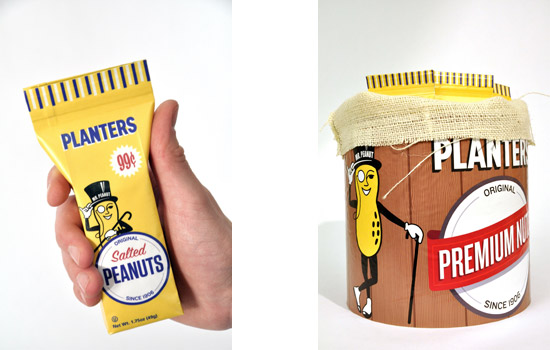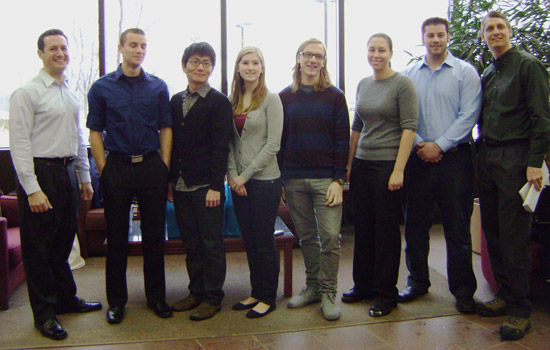Student teams redesign packaging for popular foods
Design and packaging students combine distinctive skills to improve product packages
Michelle Cometa
The redesigned package for Planters Peanuts was the winning entry in the recent American Packaging Corp./Kraft Product Design Challenge. From left to right: John Blake, manager, packaging research department at Kraft Foods; Marc Priddy (industrial design); Hong Ying Guo (packaging science); Vicki Julius (graphic design); Andrew Lakata (graphic design); Keelyn Nori (packaging science); Isaac Alves (industrial design); and David Geier, Rochester operations manager for American Packaging Corp.
Using their combined skills in graphic design, industrial design and packaging science, Rochester Institute of Technology students won top honors in the recent American Packaging Corp./Kraft Product Design Challenge at RIT.
Students from the packaging science department in the College of Applied Science and Technology worked with students from the industrial design and graphic design departments in the College of Imaging Arts and Sciences as partners in the challenge. This is the second year that classes from graphic design and packaging science worked in combined teams for the competition. It is the first year the industrial design students were added to teams.
“I think we all enjoyed working on this design challenge. It gave us a chance to design and create something tangible, not just a hypothetical class project,” says Andrew Lakata, a fourth-year graphic design student and member of the winning team that redesigned the package for Planters Peanuts.
Several popular Kraft snack packages, including Planters Peanuts, Wheat Thins, Oreos and Nutter Butters, were part of the design challenge. Each team made a formal presentation to judges from the sponsoring companies. Presentations consisted of market research, what product materials would be used and how the newly designed package could be shipped and distributed more economically. The teams modified the packages to improve consumer use, most finding ways to make the packages fit into coffee holders in vehicles, for example.
“I think our project was successful because we had a really solid concept,” Lakata explains. “We deliberated for a few weeks and it put us behind schedule a bit, but we worked out a lot of the flaws we might have overlooked in our first few ideas.
“Everything from the packaging to the graphics and form of the project fit together in the end seamlessly,” he adds. “We also put just as much time into our presentation. The presentation is just as important as the product itself; it’s what conveys your entire concept to the judges.”
Students from the top three project teams, Planters Peanuts, Fig Newtons (second-place winners), and Wheat Thins (third-place team), were each awarded $200. The first-place winners also received a gift bag of products from the sponsors. Students on the other three teams were also awarded $100 for their project designs.
“The students worked on the projects for four weeks,” says Alex Lobos, assistant professor of industrial design in the College of Imaging Arts and Sciences. “They were each from the different disciplines and needed to find common ground, and they were able to. You can see the results.”
Lobos and Lorrie Frear, assistant professor of graphic design in the College of Imaging Arts and Sciences, worked closely with Karen Proctor, professor of packaging science in the College of Applied Science and Technology to coordinate the classes. The project brought together 59 students who otherwise might not have worked with each other, Lobos says.
David Geier, Rochester operations manager for American Packaging Corp., adds: “We’re certainly planning on continuing this in the future. The competition was very close among all the teams, which really is a tribute to the hard work the students put into the program.”
 Two views of the winning package designs for Planters Peanuts. Andrew Lakata
Two views of the winning package designs for Planters Peanuts. Andrew Lakata









